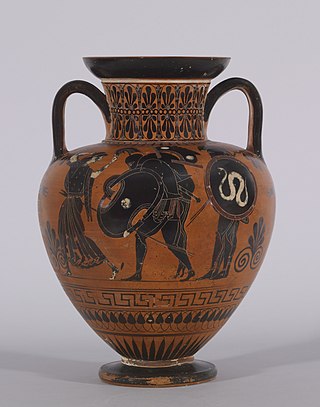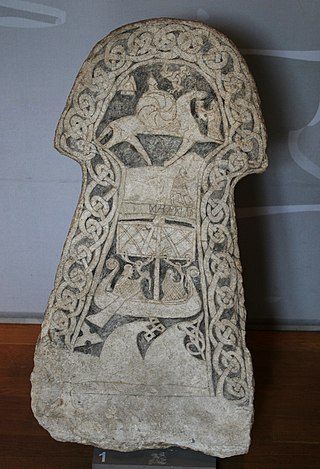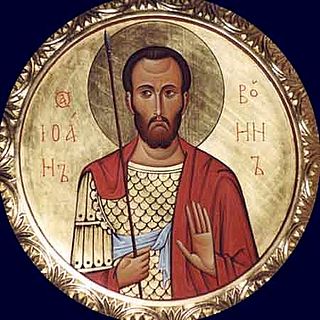External links
| | This article about a saint is a stub. You can help Wikipedia by expanding it. |
| | This biographical article about a Belgian religious figure is a stub. You can help Wikipedia by expanding it. |
Godwin of Stavelot | |
|---|---|
| Hometown | Stavelot-Malmedy, Belgium |
| Died | 690 |
| Feast | 28 October |
Saint Godwin of Stavelot was a Benedictine abbot of the monastery of Stavelot-Malmedy, Belgium, who died in 690. His feast day is October 28. His name comes from the Old English word meaning "Friend of God". This saint fought for his religious freedoms in 670 and he is known to have prayed to people in the midst of battle. He would run to the fallen troops and bravely pray over them until the battle was over. While in battle one time a warrior came up to him and threw a spear at him, but the spear broke mid flight and the warrior fell onto the ground. This was one of many miracles he performed in his lifetime.

Ajax or Aias is a Greek mythological hero, the son of King Telamon and Periboea, and the half-brother of Teucer. He plays an important role in the Trojan War, and is portrayed as a towering figure and a warrior of great courage in Homer's Iliad and in the Epic Cycle, a series of epic poems about the Trojan War, being second only to Achilles among Greek heroes of the war. He is also referred to as "Telamonian Ajax", "Greater Ajax", or "Ajax the Great", which distinguishes him from Ajax, son of Oileus, also known as Ajax the Lesser.

In Greek mythology, Hector is a Trojan prince, a hero and the greatest warrior for Troy during the Trojan War. He is a major character in Homer's Iliad, where he leads the Trojans and their allies in the defense of Troy, killing countless Greek warriors. He is ultimately killed in single combat by the Greek hero Achilles, who later drags his dead body around the city of Troy behind his chariot.

Oswald was King of Northumbria from 634 until his death, and is venerated as a saint, of whom there was a particular cult in the Middle Ages.

Saint George, also George of Lydda, was an early Christian martyr who is venerated as a saint in Christianity. According to tradition, he was a soldier in the Roman army. Of Cappadocian Greek origin, he became a member of the Praetorian Guard for Roman emperor Diocletian, but was sentenced to death for refusing to recant his Christian faith. He became one of the most venerated saints, heroes, and megalomartyrs in Christianity, and he has been especially venerated as a military saint since the Crusades. He is respected by Christians, Druze, as well as some Muslims as a martyr of monotheistic faith.

In Norse mythology, a valkyrie is one of a host of female figures who guide souls of the dead to the god Odin's hall Valhalla. There, the deceased warriors become einherjar. When the einherjar are not preparing for the cataclysmic events of Ragnarök, the valkyries bear them mead. Valkyries also appear as lovers of heroes and other mortals, where they are sometimes described as the daughters of royalty, sometimes accompanied by ravens and sometimes connected to swans or horses.

Diomedes or Diomede is a hero in Greek mythology, known for his participation in the Trojan War.
The Battle of Mactan was fought on a beach in Mactan Island between Spanish forces led by the Portuguese explorer Ferdinand Magellan along with local allies, and Lapulapu, the chieftain of the island, on the early morning hours of April 27, 1521. Magellan, a Portuguese-born commander serving the Spanish Empire who led an expedition that ultimately circumnavigated the world for the first time, commanded a small Spanish contingent in an effort to subdue Mactan led by Lapulapu under the Spanish crown. The sheer number of Lapulapu's forces, compounded with issues associated with the location and the armor, ultimately resulted in a disastrous defeat to the Europeans and the death of Magellan. Surviving members of Magellan's crew continued the expedition under the command of Juan Sebastian de Elcano, who completed the journey in September 1522.

Stavelot is a town and municipality of Wallonia located in the province of Liège, Belgium.

Michael, also called Saint Michael the Archangel, Archangel Michael and Saint Michael the Taxiarch is an archangel in Judaism, Christianity, Islam, and the Baháʼí Faith. The earliest surviving mentions of his name are in third- and second-century-BC Jewish works, often but not always apocalyptic, where he is the chief of the angels and archangels, and he is the guardian prince of Israel and is responsible for the care of Israel. Christianity conserved nearly all the Jewish traditions concerning him, and he is mentioned explicitly in Revelation 12:7–12, where he does battle with Satan, and in the Epistle of Jude, where the author denounces heretics by contrasting them with Michael.
Buile Shuibhne or Buile Suibne is a medieval Irish tale about Suibhne mac Colmáin, king of the Dál nAraidi, who was driven insane by the curse of Saint Rónán Finn. The insanity makes Suibhne leave the Battle of Mag Rath and begin a life of wandering. He dies under the refuge of St. Moling.

The Batrachomyomachia or Battle of the Frogs and Mice is a comic epic, or a parody of the Iliad.
Folklore of the Luo peoples of Kenya speaks of a mighty warrior known as Lwanda Magere. He was born in the year 1720 to Abonyo Wuod Omolo and his mother, Nyabera. After his mother died during his birth, he was taken into the care of his grandmother, Rapondi. His father died in one of the numerous wars with their Nandi neighbors when Magere was barely a teenager. He belonged to the Sidho clan in Kano, on the shores of Lake Victoria. The Sidho clan occupies the present-day sugar belt at the foot of the Nandi escarpment. He possessed unearthly powers, and his flesh was made of stone. He deflected arrows, spears and clubs, making him invincible during war. He was famously known for his capability to tear an entire army apart on his own.
In the Ulster Cycle of early Irish literature, the Lúin of Celtchar is the name of a long, fiery lance or spear belonging to Celtchar mac Uthechar and wielded by other heroes, such as Dubthach, Mac Cécht and Fedlimid.

The Stavelot Triptych is a medieval reliquary and portable altar in gold and enamel intended to protect, honor and display pieces of the True Cross. Created by Mosan artists—"Mosan" signifies the valley of the Meuse river—around 1156 at Stavelot Abbey in present-day Belgium. The work is a masterpiece of Romanesque goldsmith's work and is today in the Morgan Library & Museum in New York City.

End of the Spear is a 2005 American biographical adventure drama film directed by Jim Hanon, written by Bill Ewing, Bart Gavigan and Hanon, and stars Louie Leonardo and Chad Allen. The film recounts the story of Operation Auca, in which five American Christian missionaries attempted to evangelize the Waodani people of the tropical rain forest of Eastern Ecuador.

The period of Anglo-Saxon warfare spans the 5th century AD to the 11th in Anglo-Saxon England. Its technology and tactics resemble those of other European cultural areas of the Early Medieval Period, although the Anglo-Saxons, unlike the Continental Germanic tribes such as the Franks and the Goths, do not appear to have regularly fought on horseback.

Saint Michael the Archangel is referenced in the Old Testament and has been part of Christian teachings since the earliest times. In Catholic writings and traditions he acts as the defender of the Church and acted as the opponent of Satan, He also assists people at the hour of death.

Mercurius was a Roman soldier of Scythian descent who became a Christian saint and martyr. He was born in the city of Eskentos in Cappadocia, in Eastern Asia Minor. According to Christian tradition, he was the soldier who killed Julian the apostate during his campaign in Persia. Saint Mercurius was also widely known by his Arabic-language name Abu-Sayfain, Abu-Sifin or Abu-Sefein in Egyptian Arabic which means "father of two swords", referring to the second sword given to him by the Archangel Michael.

John the Warrior or John the Soldier in the Catholic Church is a Christian saint and martyr. He was born in the 4th century and lived until his death in the Byzantine Empire. Forced by Julian the Apostate to serve as a warrior against Christianity, he was imprisoned after being caught helping people in need or defending Christians, and awaited there his death penalty. However, John the Warrior was released after the death of the emperor during a war.
The Cairn on the Headland is a short story by American writer Robert E. Howard, with elements of fantasy and horror. As often in Howard stories, there is a link to the Cthulhu Mythos, in this case mixed also with elements of both Norse Mythology and Catholic Christianity.